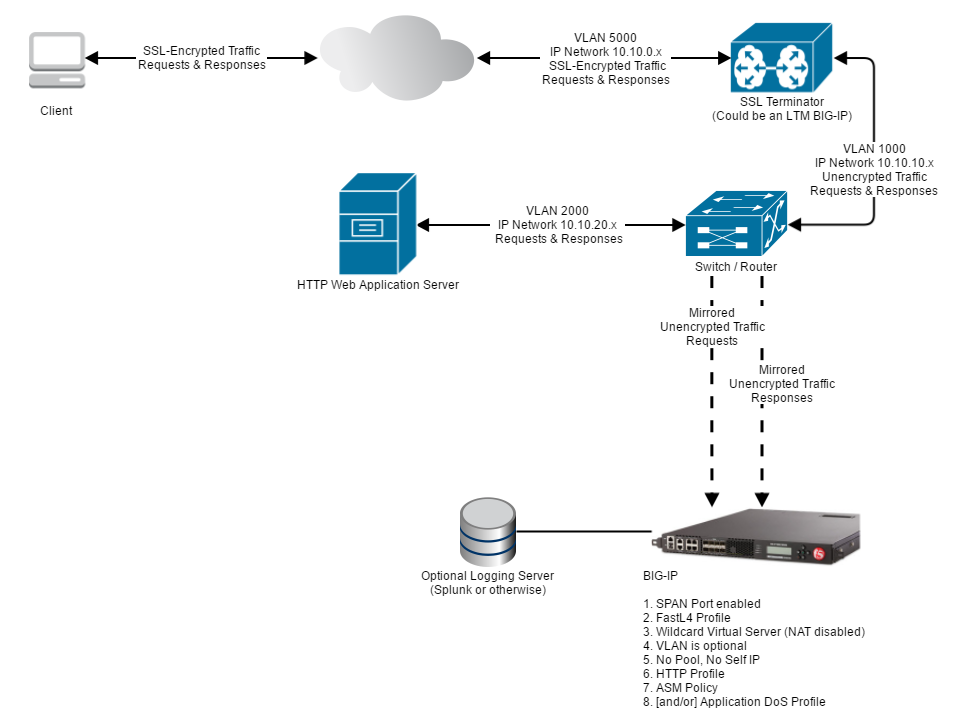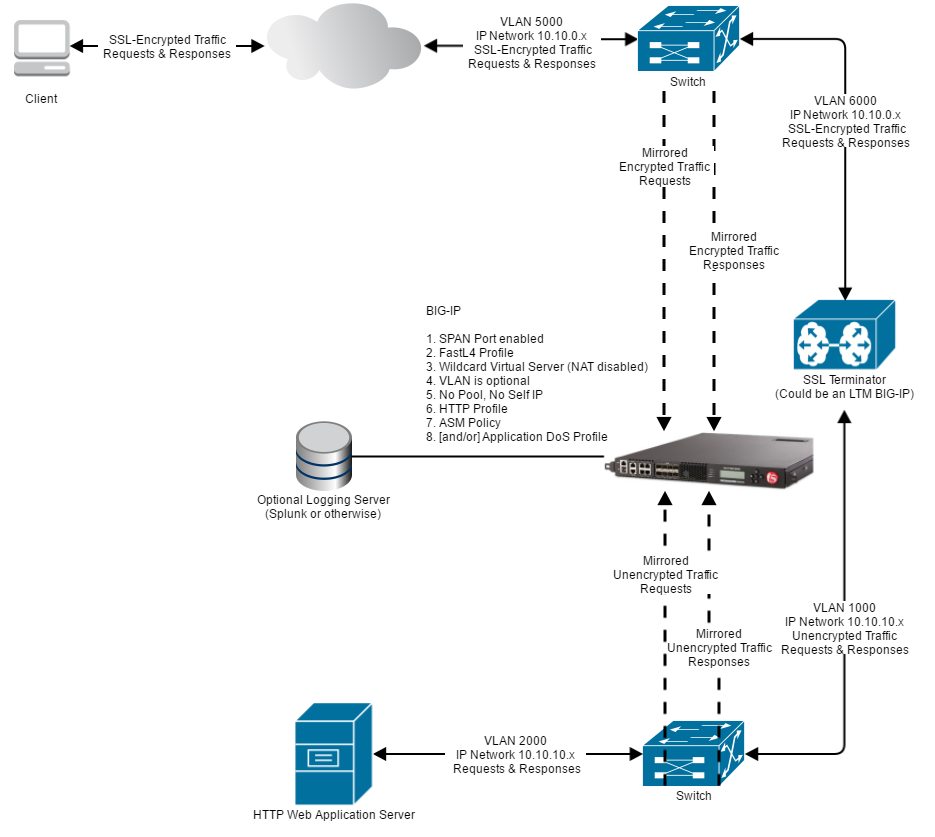Applies To:
Show Versions
BIG-IP ASM
- 13.1.5, 13.1.4, 13.1.3, 13.1.1, 13.1.0
Overview: Configuring the BIG-IP System Passive Monitoring
You can configure a physical interface on a BIG-IP ®system to operate in passive mode. In this mode, the interface accepts mirrored traffic from another device for analysis of Layer 7 traffic.
Passive mode behavior
Using a configured ASM passive monitoring policy and/or ASM DoS profile, the system analyzes the mirrored traffic, displays the resulting reports and sends the resulting analytics data and log messages to a remote analytics and logging server. The mirrored traffic never leaves the system, and the BIG-IP system never acts on the headers and payload. The logs report the actions the system would have taken if it were not in passive mode.
Benefits of DoS Layer 7 passive monitoring
It allows Layer 7 monitoring of attacks and discovers system vulnerabilities while being quick and easy to deploy. The existing network topology does not need to be changed and VLANS and IP addresses are not configured.
Sample configuration
- ASM Layer 7 policy: DoSL7 and ASM need to be mirrored after the SSL terminator since they need to work with unencrypted data.
- ASM DoS profile: Network DoS needs to work on traffic mirrored before the SSL terminator. Otherwise, we are not protecting the SSL terminator.
This illustration shows a configuration for ASM policy passive monitoring.
This illustration shows a configuration for DoS profile passive monitoring
Common use case
Passive monitoring of DoS Layer 7 is for evaluation purposes only.
Prerequisite configuration
- DoS Layer 7 and ASM traffic works on unencrypted data so their traffic needs to be mirrored after the SSL terminator.
- Network DoS works on encrypted data so its traffic needs to be mirrored before the SSL terminator.
In addition, you need to enable the appropriate database variable depending on the configuration you are using. This allows you to associate the ASM policy or DoS profile with a FastL4 virtual server, which is required for this feature. If you are configuring passive monitoring with a DoS profile, on the command line, type the following:
tmsh modify sys db dosl7.fastl4_allow value enable
If you are configuring passive monitoring with an ASM security policy, type the following:
tmsh modify sys db asm.fastl4_allow value enable
Creating a passive monitoring ASM security policy
Passive security policy supported features
The following details the ASM security policy features and what is supported in passive mode.
| Feature | Parts Supported | Parts Not Supported |
|---|---|---|
| Enforcement Mode | Transparent |
Blocking If this is selected, blocked transactions will be shown in the logs as being blocked, while they are actually passed. |
| Violations Settings | Learn, Alarm |
Block If this is selected, blocked transactions will be shown in the logs as being blocked, while they are actually passed. |
| Policy Building |
Manual, Automatic Based on IP addresses only (including trusted IPs) Centralized Policy Builder (Requires a Separate Forwarding Port) |
Learning based on Device ID is not supported. |
| Attack Signatures | Fully Supported (Request and Response) | - |
| Content Profiles | Fully Supported | Content-Based Routing |
| File Types | Fully Supported | - |
| IP Intelligence | Fully Supported | - |
| Geolocation Enforcement | Fully Supported | - |
| Headers | Fully Supported | - |
| Dynamic Session ID in URL | Fully Supported | - |
| Vulnerability Assessments | Resolutions are supported according to the features they enable as specified in
this table. (Requires a Separate Forwarding Port) |
- |
| Antivirus protection (ICAP) | None | Not Supported |
| Database Security | None | Not Supported |
| Bypassing of Search Engines | None | Not Supported |
| Login Enforcement | None | Not Supported |
| Session Tracking | None | Not Supported |
| CSRF Protection | Only Verify Origin enforcement mode is supported. | Verify CSRF Token is not supported. |
| Web Scraping | None | Not Supported |
| Single Page Application | None | Not Supported |
| Content-Based Routing (CBR) | None | Not Supported |
| Brute Force |
|
Any action except for
"Alarm"
|
|
CORS (Cross-Origin Request Sharing) |
Only when "Enforce on ASM" is selected, and only for alarming a violation upon an illegal origin. |
CORS headers are not modified. |
| WebSocket Enforcement | All Except ----> |
Remove all CORS headers WebSocket Extensions:
|
| URL Enforcement | All Except ----> | URL Flows |
| Parameters | All Except ----> | Dynamic Extractions |
| Data Guard |
|
Mask Data: Masking the responses on the network will not be done. |
| Cookies | Allowed Cookies | Enforced Cookies |
| iRules | None | Not Supported |
| Logging and Reporting |
|
|
Passive monitoring DoS profile
Creating a passive monitoring DoS profile
Passive monitoring volumentric DoS Layer 7
The following details the ASM volumetric DoS Layer 7 features and what is supported in passive mode.
| Features | Parts Supported | Parts Not Supported |
|---|---|---|
|
TPS-Based Detection (Enforcement mode) |
|
- |
|
Stress-based Detection (Enforcement mode) |
|
Detection of Server Stress is done as "best effort". In case the switch that is doing the mirroring becomes congested, a Layer 7 DoS attack may be detected, although the problem is actually at the Layer 3 switch. |
| Mitigation |
|
- |
| Thresholds Mode |
Fully Supported:
|
- |
| Heavy URL Protection | Fully Supported | - |
| Record Traffic | Supported on single host VS | Not supported on catch-all Virtual Servers (those with any/any destination) |
| Bot Signatures |
|
- |
| Geolocations |
Fully Supported:
|
- |
| Proactive Bot Defense | None | Not Supported |
| Single Page Application | None | Not Supported |
| Trigger iRule | IN_DOSL7_ATTACK event | Blocking or modifying traffic from iRules |
| Logging and Reporting |
Fully Supported:
|
Note: Server Health and average server latency is on "best effort": In case the switch that is doing the mirroring becomes congested, these values may be wrong. The server health may be shown as low, although the problem is actually at the L3 layer switch. |
Passive monitoring behavioral analysis DoS Layer 7
The following details the ASM behavrioral analysis DoS Layer 7 features and what is supported in passive mode.
| Features | Parts Supported | Parts Not Supported |
|---|---|---|
| Mitigation | - |
|
| Bad actors behavior detection | Detection | Mitigation |
| Request signatures detection | Detection | Mitigation |
| Logging and Reporting |
Fully Supported:
|
Note:
|
Passive monitoring test considerations
When testing the passive monitoring feature, keep the following observations in mind.
| Feature | Notes | Observations when feature is enabled |
|---|---|---|
| Login Enforcement | - | Even after a successful login, every request for the Authenticated URL would cause a violation. |
| Session Tracking | Includes Session Hijacking and Session Awareness. | Request is not logged after the first 10 requests and there is no violation. |
| Web Scraping | - | Request is not logged after the first 10 requests and there is no violation. |
| Single Page Application | - | This feature is completely based on injected JavaScript. Since JavaScript is not injected in passive mode, the feature does not work. |
| CSRF Protection | Verify CSRF Token is not supported. | The enforcement based on origin works the same as for inline BIG-IP systems.
CSRF token enforcement does not work because it is based on JavaScript and cookies injection. Every Request to URL where token verification is required raises a CSRF violation. |
| Brute Force | The following are not supported:
|
Under one of the following conditions, a request is not logged after the first 10
requests and there is no violation:
|
| CORS | The following are not supported:
|
CORS headers are not removed and not replaced. |
| WebSocket Enforcement | The following are not supported:
|
CORS headers are not removed and not replaced. |
| Enforced Cookies | - | Every request with one enforced cookie included causes a violation. |
| URL Flow | - | Every request for the configured URL causes a violation. |
| Dynamic Extractions | - | Every request related to dynamic extraction causes a violation. |
| Session Tracking Reports | - | Reports only show the first 10 requests. |
| Web Scraping Reports | - | Statistics are not reported. |
| Policy Builder | Learning based on Device ID is NOT supported. | No effect on traffic after enabling Device ID. Policy builder still learns suggestions from IP |
| Anti-Virus protection (ICAP) | - | Violation is not detected and there is no side effect. |
| Database Security | - | Not tested |
| Bypassing of Search Engines | - | No matter what User Agent / XFF value is used, only the first 10 requests are logged. There is no violation |
| iRules | - |
|





